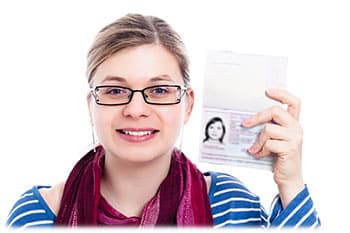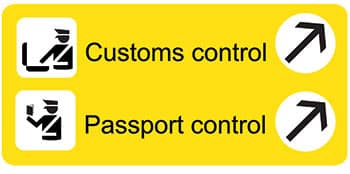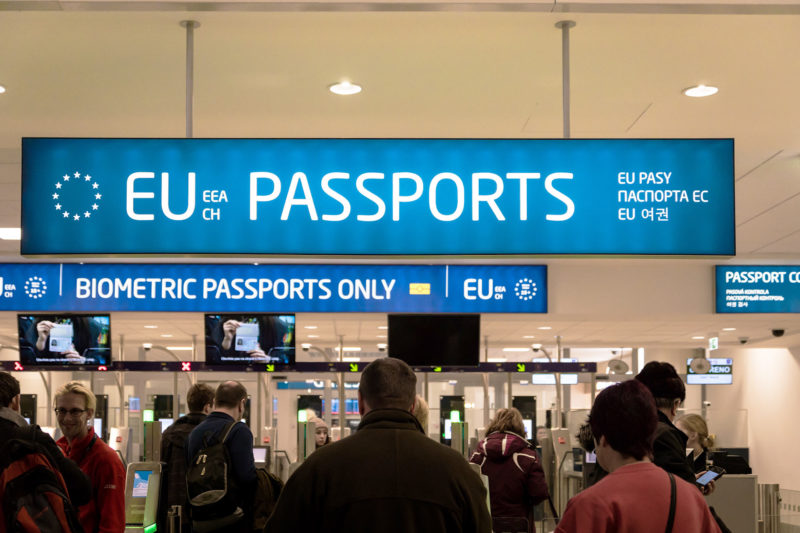 Passport Control has three signs: 1) Non-EU, 2) EU only, and 3) EU Only, but with priority for diplomatic staff and flight crews. Most nationalities do not require a visa to enter the country, but you can check here. Compared to other EU airports, passport control can sometimes be relatively slow (this is most likely true if you arrive during peak times, from 10:00 a.m. to 2:00 p.m.). There are 12 passport gates, but generally, not all of them are attended at once. Overall, security at Prague Airport is strict but efficient.
Passport Control has three signs: 1) Non-EU, 2) EU only, and 3) EU Only, but with priority for diplomatic staff and flight crews. Most nationalities do not require a visa to enter the country, but you can check here. Compared to other EU airports, passport control can sometimes be relatively slow (this is most likely true if you arrive during peak times, from 10:00 a.m. to 2:00 p.m.). There are 12 passport gates, but generally, not all of them are attended at once. Overall, security at Prague Airport is strict but efficient.
There is no passport control if you arrive within the Schengen zone (all flights to/from Terminal 2). Most EU countries are now part of Schengen (excluding the UK).
Prague Airport E-Gate (Terminal 1)
 Prague Airport offers travellers the option of automatic passport checking through the so-called “E-Gate”. Based on Easy Go technology, the new equipment enables citizens of the European Union, the European Economic Area, and Switzerland to take advantage of self-service checking, provided they are holders of biometric passports and are over 18. From start to finish, the entire checking process in the E-Gate lasts 12 -20 seconds. Utilizing the new technology will substantially increase the airport’s passport-checking capacity. The E-Gate is available to passengers arriving in Terminal 1 (passengers arriving in Terminal 2 do not need to pass immigration as all flights are from the Schengen zone).
Prague Airport offers travellers the option of automatic passport checking through the so-called “E-Gate”. Based on Easy Go technology, the new equipment enables citizens of the European Union, the European Economic Area, and Switzerland to take advantage of self-service checking, provided they are holders of biometric passports and are over 18. From start to finish, the entire checking process in the E-Gate lasts 12 -20 seconds. Utilizing the new technology will substantially increase the airport’s passport-checking capacity. The E-Gate is available to passengers arriving in Terminal 1 (passengers arriving in Terminal 2 do not need to pass immigration as all flights are from the Schengen zone).
Automated Border Control System (E-gate)
What is EasyGO?
EasyGO is an automated border control system that allows easy and quick passage through border control using biometric gates. It’s available for passengers on the departure and arrival halls of Terminal 1 of Vaclav Havel Airport Prague. Passengers are welcome to try and see that electronic gates are a modern, elegant and pleasant way to pass the border.
Who can use EasyGO?
EasyGO can be used by all passengers possessing a new type of travel document containing an electronic chip who are older than 15 years and are using a passport issued by one of the EU countries, Switzerland or EEA countries.
How do I recognize an electronic travel document?
An electronic travel document is a personal document that contains a chip with your biometric data (facial image and fingerprints).
How to use EasyGO?
It’s easy. Insert the travel document into the reader at the biometrical gate’s entrance. Put the page with a photograph face down on the reader’s glass. After reading the data from the travel document, the entry gate opens. Enter the gate and stand on the position marked with white feet stickers. Look straight into the camera and do not move. Border control will be completed in a matter of seconds. On the screen in front of you, the pictogram with the border check appears, and the exit door of the gate opens. You have passed the border control successfully; please leave the gate.
How to avoid complications during border control?
If the system detects any discrepancy, pictograms on the screen will guide the passenger to a manual police check. It means it is not possible to recognize the passenger’s face securely and compare it to the photograph saved in the chip of the travel document. This might be caused by a face covered with a hat, scarf, sunglasses, etc. The system also signals a discrepancy when the traveller has glasses on his face, not on the photograph or when a man is photographed with a distinct beard. Still, it passes the biometrical gate without any beard and vice versa.
Are there any health risks?
No. The device does not present a health risk to passengers. It does not emit any radiation; it only does passive detection. The biometric camera is a standard camera for taking live pictures, similar to the one you use in your notebook or mobile phone.

